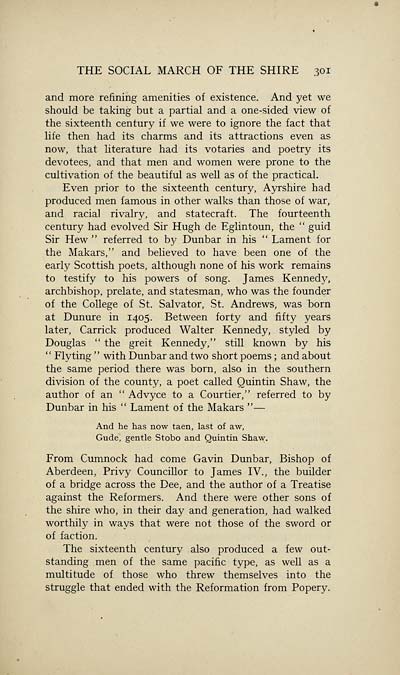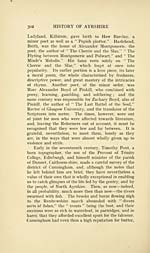Download files
Complete book:
Individual page:
Thumbnail gallery: Grid view | List view

THE SOCIAL MARCH OF THE SHIRE 301
and more refining amenities of existence. And yet we
should be taking but a partial and a one-sided view of
the sixteenth century if we were to ignore the fact that
life then had its charms and its attractions even as
now, that literature had its votaries and poetry its
devotees, and that men and women were prone to the
cultivation of the beautiful as well as of the practical.
Even prior to the sixteenth century, Ayrshire had
produced men famous in other walks than those of war,
and racial rivaln?, and statecraft. The fourteenth
century had evolved Sir Hugh de Eglintoun, the " guid
Sir Hew " referred to by Dunbar in his " Lament for
the Makars," and believed to have been one of the
early Scottish poets, although none of his work remains
to testify to his powers of song. James Kennedy,
archbishop, prelate, and statesman, who was the founder
of the College of St. Salvator, St. Andrews, was born
at Dunure in 1405. Between forty and fifty years
later, Carrick produced Walter Kennedy, styled by
Douglas " the greit Kennedy," still known by his
" Fly ting " with Dunbar and two short poems ; and about
the same period there was born, also in the southern
division of the county, a poet called Quintin Shaw, the
author of an " Advyce to a Courtier," referred to by
Dunbar in his " Lament of the Makars " —
And he has now taen, last of aw,
Gude, gentle Stobo and Quintin Shaw.
From Cumnock had come Gavin Dunbar, Bishop of
Aberdeen, Privy Councillor to James IV., the builder
of a bridge across the Dee, and the author of a Treatise
against the Reformers. And there were other sons of
the shire who, in their day and generation, had walked
worthily in ways that were not those of the sword or
of faction.
The sixteenth century also produced a few out-
standing men of the same pacific type, as well as a
multitude of those who threw themselves into the
struggle that ended with the Reformation from Popery.
and more refining amenities of existence. And yet we
should be taking but a partial and a one-sided view of
the sixteenth century if we were to ignore the fact that
life then had its charms and its attractions even as
now, that literature had its votaries and poetry its
devotees, and that men and women were prone to the
cultivation of the beautiful as well as of the practical.
Even prior to the sixteenth century, Ayrshire had
produced men famous in other walks than those of war,
and racial rivaln?, and statecraft. The fourteenth
century had evolved Sir Hugh de Eglintoun, the " guid
Sir Hew " referred to by Dunbar in his " Lament for
the Makars," and believed to have been one of the
early Scottish poets, although none of his work remains
to testify to his powers of song. James Kennedy,
archbishop, prelate, and statesman, who was the founder
of the College of St. Salvator, St. Andrews, was born
at Dunure in 1405. Between forty and fifty years
later, Carrick produced Walter Kennedy, styled by
Douglas " the greit Kennedy," still known by his
" Fly ting " with Dunbar and two short poems ; and about
the same period there was born, also in the southern
division of the county, a poet called Quintin Shaw, the
author of an " Advyce to a Courtier," referred to by
Dunbar in his " Lament of the Makars " —
And he has now taen, last of aw,
Gude, gentle Stobo and Quintin Shaw.
From Cumnock had come Gavin Dunbar, Bishop of
Aberdeen, Privy Councillor to James IV., the builder
of a bridge across the Dee, and the author of a Treatise
against the Reformers. And there were other sons of
the shire who, in their day and generation, had walked
worthily in ways that were not those of the sword or
of faction.
The sixteenth century also produced a few out-
standing men of the same pacific type, as well as a
multitude of those who threw themselves into the
struggle that ended with the Reformation from Popery.
Set display mode to:
![]() Universal Viewer |
Universal Viewer | ![]() Mirador |
Large image | Transcription
Mirador |
Large image | Transcription
Images and transcriptions on this page, including medium image downloads, may be used under the Creative Commons Attribution 4.0 International Licence unless otherwise stated. ![]()
| Histories of Scottish families > Ayrshire > Volume 1 > (311) Page 301 |
|---|
| Permanent URL | https://digital.nls.uk/95198018 |
|---|
| Attribution and copyright: |
|
|---|
| Description | A selection of almost 400 printed items relating to the history of Scottish families, mostly dating from the 19th and early 20th centuries. Includes memoirs, genealogies and clan histories, with a few produced by emigrant families. The earliest family history goes back to AD 916. |
|---|

